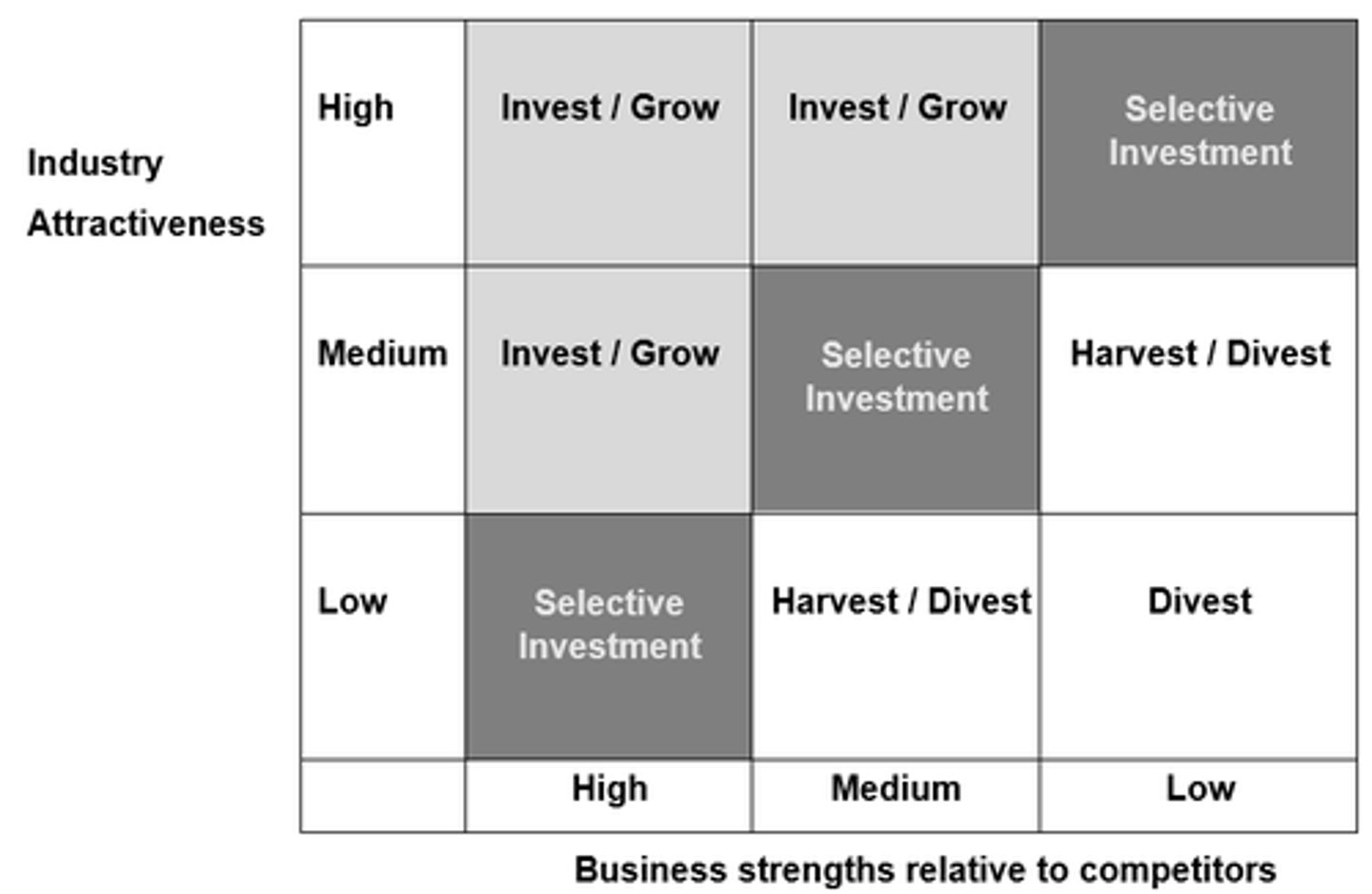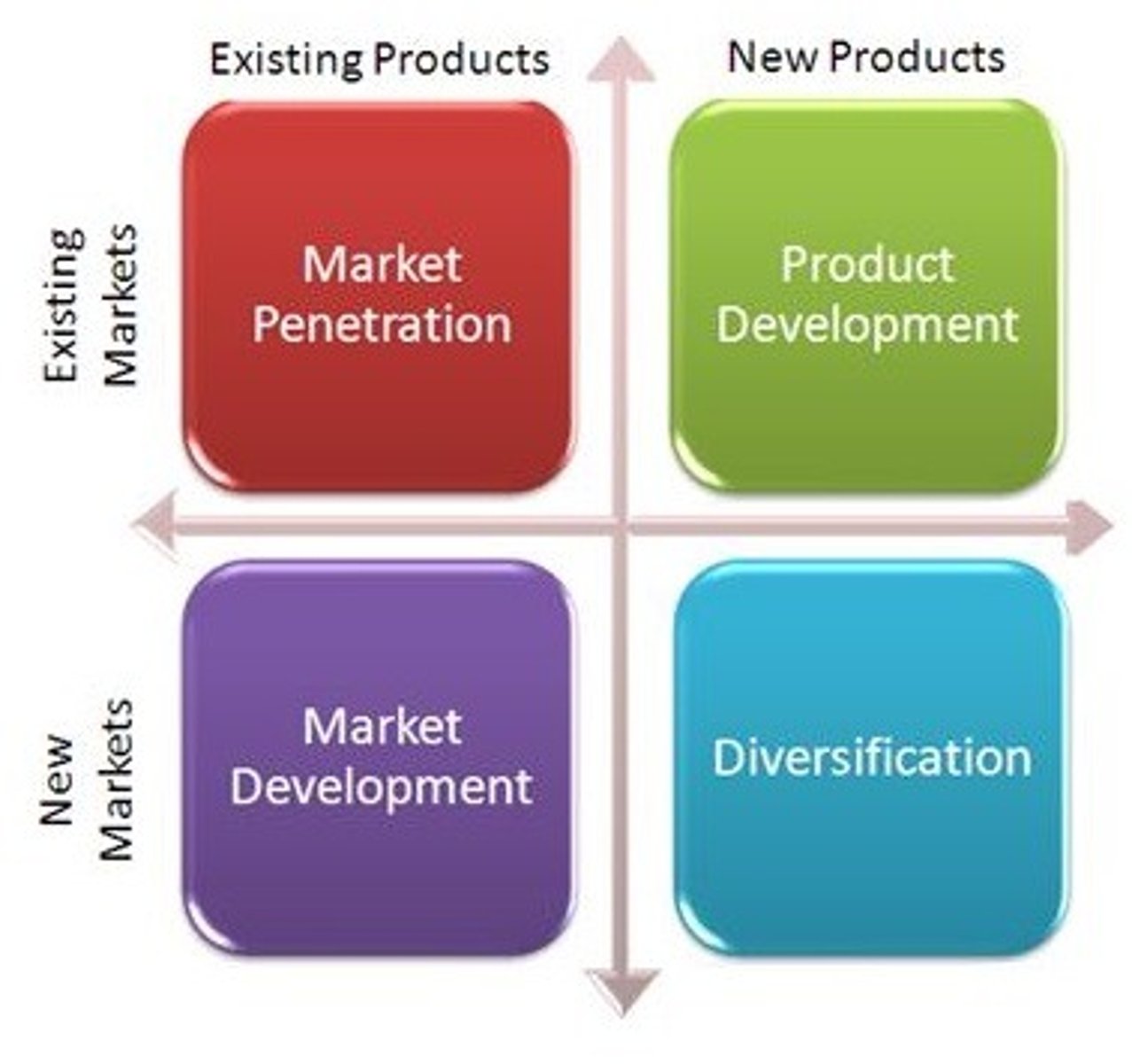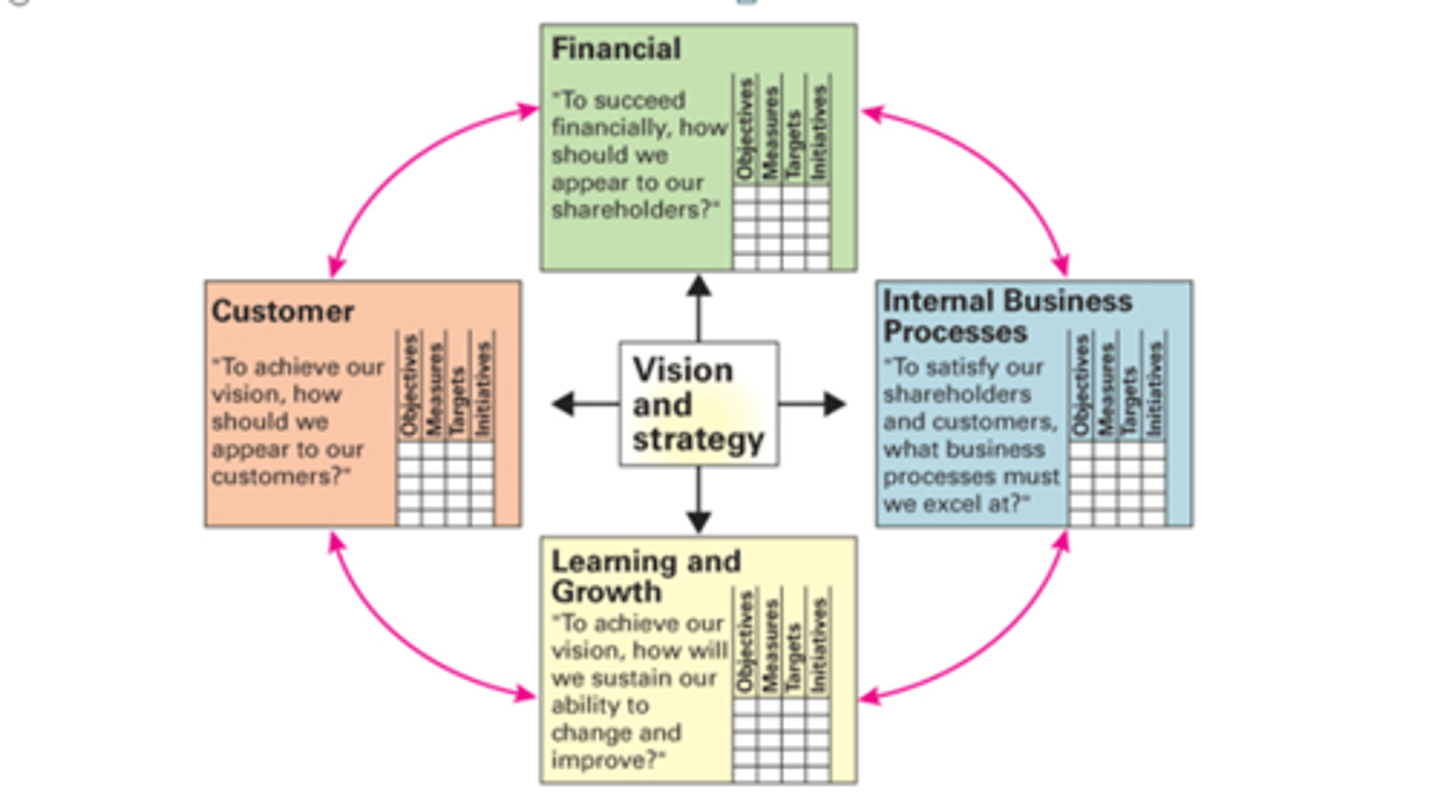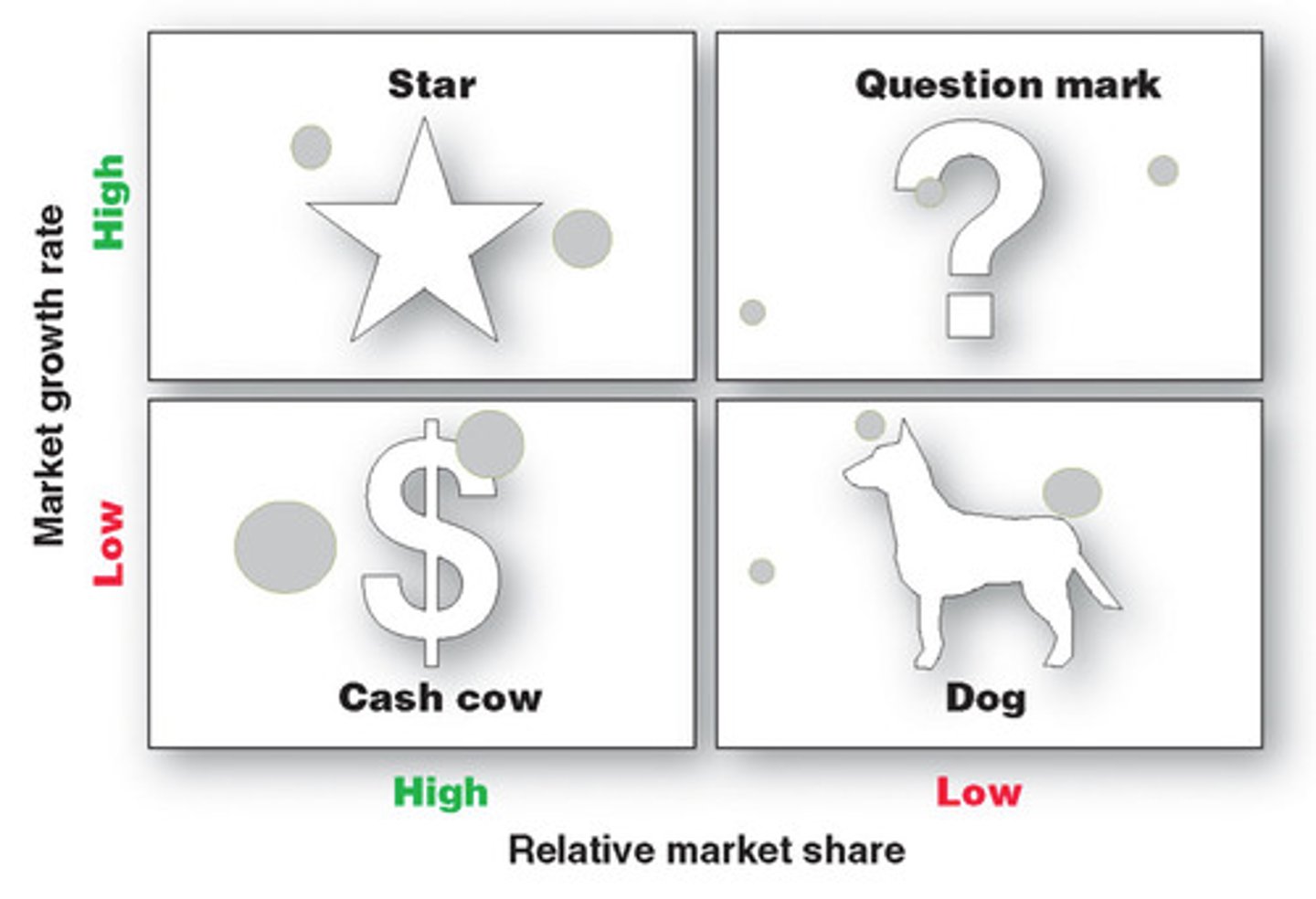Strat Pol Midterm - David Kee
1/98
There's no tags or description
Looks like no tags are added yet.
Name | Mastery | Learn | Test | Matching | Spaced |
|---|
No study sessions yet.
99 Terms
Chess is like _______ it is a ______ sport rooted in _____ & _______
strategy; competitive; art and science
As strategy relates to business, what is important:
strategy is everything; you must outthink your opponent
As strategy relates to business, how is science involved
It is measurable - all goals have numbers and are measurable
You can only manage that which you can measure
peter drucker
Business level strategy:
- An __________ and ________________ set of ________ ______ ______ a firm uses to gain a _______ _______ by exploiting _______ __________ in ____ ____ ___
integrated; coordinated; commitments and actions; competitive advantage; core competencies; specific product markets
Strategic Management - taking care of strategy
the _________ & __________ of ________, __________, __________cross-functional decisions that enable an organization to achieve its ______________________
art & science; formulating, implementing, evaluating; objectives
Why is strategic management best
Why strategic management is best?
- Covers both Strategic Planning and Strategic Policy
o Strategic Planning - part of strategy formulation
o Strategic Policy - strategy implementation
Strategic Planning
- part of strategy formulation
Strategic Policy
- strategy implementation
What does strategic management involve
- Tough management choices, among good alternatives, commitment to markets, policies, procedures and operations
Strategic Modeling: The stages of Strategic Management
1. Formulation
2. Implementation
3. Evaluation
Phase 1 - Strategy Formulation
-________ includes developing a ________ and _______ identifying an organization’s ________ ________ & _____________ determining ________ ______________ & ____________ establishing long term objectives, generating _________ ___________, and choosing _______ ____________ to pursue.
vision; mission; external opportunities and threats; internal strengths and weaknesses; alternative strategies, particular strategies
Strategy Formulation examples
What businesses enter/abandon, allocating resources, expanding or diversifying, merges and acquisitions, joint ventures, avoiding a hostile takeover, entering international markets
Phase 2 - Strategy Implementation
- Requires a firm to establish _________ _________, __________ ___________, ______ _________ and ___________ ____________ so that formulated strategies can be _________.
annual objectives, devise policies, motivate employees, allocate resources; executed
Often called "the action stage" where things happen
Strategy Implementation
No actions happen in the _______ stage
formulation
Phase 3 - Strategy Evaluation
Reviewing ____________ & _____________ _____________ that are the bases for current strategies, measuring ___________ and taking __________ ____________
- external and internal factors; performance; corrective actions.
There are 3 levels of strategy:
Corporate Strategy
Divisional Strategy
Business Unit Level Strategy
Corporate strategy is
economy oriented, Big picture, multi-level, hierarchical
Divisional strategy is
Market oriented
Business Unit Level Strategy
o Small Business level oriented
Strategic Management helps a firm function as a
competitive team
Competitive Advantage – Anything a firm does ________ well compared to____________ firms – not just other firms.
Especially; rival
Strategists
_____________ ____________ ________ for the success or failure of an organization. People focused on developing _____________.
individuals most responsible; strategies.
Examples of people who must be strategists
Small business owners must be, corporate executives, etc
circuit city
successful by selling TVs at a good time, then overspent and became outdated, focused on revenue over profit
cut a ton of employees-
The CFO had the ear of CEO
Cut 3500 sales people "most expensive" on the same day.
These managers were let go, and by 2008 (They did this March 28, 2007), they were filing for bankruptcy. Took 6-9 months to go out of business
Examples of poor decision makers
Blockbuster bypass Netflix
Kodak didn't go digital
David Kee's personal business trying to sell gelato
What does business failure show us
Lack of humility and professional will
Vision Statement:
Answers __________ "What do we _____ _____ _____ ",
question; want to become
Vision statement is often considered the
1st step of strategic planning
Vision statement looks to the ________, is ____________, and is how we ______ _________
future; internal; see ourselves
Mission statement
Enduring _______ _______ _________ ___________ one business from other _______ firms. Identifies the ________ of firm's ________ in ______ & ________ terms,
address basic ____________ faces all strategists -
_________ _________ ___________ ___________. (Seen as) - external how perceived.
statement of purpose; similar; scope; operations; product and market; questions; what is our business seen as - external how we perceived
Vision Statement:
an _________ statement describing the __________ of the company for the __________ of _________ & __________ __________ to the company
internal; future; purpose; inspiring & giving direction;
Mission statement
A ________ - ________ sentence which ________ to the ______ the __________, ___________, and __________ of the company
1-2; states; public; purpose, contribution, and distinction
What are important reasons for Mission and vision statements
- To make sure all employees/managers understand the firm's purpose or reason for being.
- To provide a basis for prioritization of key internal and external factors utilized to formulate feasible strategies.
- To provide a basis for the allocation of resources.
- To provide a basis for organizing work, departments, activities, and segments around a common purpose
Objectives
__________ results that an organization ________ ________ ________ in _________ its ____________ ____ for the ________ term
Specific; seeks to achieve; pursuing; basic mission; long
Objectives should be _______, ___________, _________, _________, and __________
challenging, measurable, consistent, reasonable, clear
SMART GOALS:
Specific, Measurable, Achievable, Relevant, Time-Bound
Strategies
the ___________ by which ________ term ___________ will be achieved
moves; long; objectives
Policies
the _____________ by which ___________ objectives will be achieved
means; annual
5 P'S of Coke
1. Profit
2. People
3. Portfolio
4. Partners
5. Planet
Industry Organizational Approach to competitive advantage
believes that ___________ factors are _______ important than _________ factors in a firm for __________ & __________ _______ _____________. An important part of an ________ ________ is __________ ___ ___________ __________
external (industry); more; internal factors ; gaining and sustaining competitive advantage.
external audit is identifying a rival firm
Core Competency
multiple ________ & _________ that _________ a firm in the _________ and therefore are the ________ of a company's ____________
resources and skills; distinguish; marketplace; foundation; competitiveness
Resource Based View
Approach _________ that ________ _________ are ____________ important for a ____________ than __________ factors in ________ & __________ _________ _____.
contends; internal resources; firm; external; achieving and sustaining competitive advantage
What is a GE Matrix
Compares (Y-Axis) Industry Attractiveness to Business Unit Strength (X axis)
goes toward the left on X-Axis

Ansoff Matrix
analytical tool devise various product and market growth strategies:
Market Present vs. Market Future & Product Present vs. Product Future
Does businesses want to market new or existing products in either new or existing markets.

In Ansoff Matrix
Market Penetration
Market Development
Product Development
Diversification
1. Market Penetration - Lowest risk - selling same products to the same types of customers (market/product present)
2. Product Devlopment - Medium Risk selling new products to Existing Customers (market present product future)
3. Market Development - Medium Risk - selling same products to new customers (Market Future/Product Present)
4. Diversification - highest risk - selling new products to new customers (Market Future/Product Future)
Difference Between Reengineering and Restructuring
Restructuring: tweaking what's already there, move things around, changing pieces not overall design. restructuring cost reduction; fire and hire new people; a defensive strategy; easier for people to handle this strategy.
Reengineering: Changing the design and structure from scratch by coming up with a whole new system. Gutting things. Face more resistance. The most complex form; questioning every process and function to determine if it is effective for the purpose of the business; involves starting over with new ideas; requires good motivational strategies
Difference between implementation and formulation
Formulation is EFFECTIVENESS - the positioning of forces before action, intellectual process, that requires intuitive and analytical skills. Takes more time.
Implementation is EFFICIENCY - the management of forces during action, operational processes, special motivation and leadership skills. Less time (deadlines).
The Balanced Scorecard
How did you do vs. your objectives and goals?
Is the firm continually improving and creating (innovation, technological leadership, product quality, operational process efficiencies)
Is the firm sustaining and even improving on its core competencies and competitive advantages?
How satisfied are the firm's customers?

Four areas of the balanced scorecard
1. Finances
2. Innovation and Growth
3. Processes
4. Relationships
The goal of the balanced scorecard is
alignment
Blue Ocean Strategy is also known as the
Lazy Dreamer Strategy
What is the Blue Ocean Strategy
1. thinking of something new
2. Have a product that works
Don't want competition, innovative, create a new market where no one is.
Creating Demand.
downfall - impossible to stay in blue ocean because of competition, short lived, and competitors often make money
What is the Red Ocean
Evolutionary Strategy of Darwin "survival of the fittest." Market Goal = survival or last one standing. Treading water. Current Market = cut throat competition, filled w/ blood making it red (Alice in Wonderland Looking Glass). Ex: Airline Industry
Red Queen effect
a phenomenon seen in coevolving populations- to maintain relative fitness, each population must constantly adapt to the other
Delta Model
Hippie Strategy - Love not War - Relationship oriented: we want people to love us so much they don't even think about choosing anyone else, and they don't know why.
1. Best Product Positioning
2. Total Customer Solutions
3. System Lock in
Disruptive Innovation
an innovation that leverages new technologies to attack existing markets from the bottom up - bring creative destruction to the market
Kotter's Leading Change (CBFEEGSI)
8 Stages - as the leader goes, so does the company. Risk of Leadership/Management Fallacy
create, build, form, enable, enlist, generate, sustain, institute
What is the BCG Matrix
a means of evaluating strategic business units on the basis of (1) their market growth rates and (2) their relative market share
1. Star
2. Cash Cow
3. Question Mark
4. Dog

In BCG Matrix
1. Star = High, stably growing earnings: CF = Neutral ... Invest for Growth
2. Cash Cow = High, stable earnings and cash flow... Milk it
3. Question mark = Low, Unstable or Growing Earnings, negative CF, Analyze. Becomes Star or Dog
4. Dog = Earnings unstable, low, negative or neutral CF ... divest
Minceberg's 5 P's
1) Plan - develop a strategy in advance with a purpose
2) Ploy - one of the ways to outsmart the competition such as buying patents to competitors cannot launch a rival product
3) Pattern - successful aspects of the past can lead to success in the future
4) Position - the way organization relates to its competitive environment and what it can do to make it a unique product in the marketplace
5) Perspective - influence of organizational culture and collective thinking on the strategic decision making within the company
Porter's 5 Forces Model
analyzes the competitive forces within the environment in which a company operates to assess the potential for profitability in an industry
CENTER: Rivalry Among existing competitors
LEFT - Power of Suppliers
RIGHT - Power of BUyers
Top - Potential New Entrants
Bottom - Threat of Substitute Products or Services

Dr. T came to class - What did he talk about
The importance of Listening
2. Processing what you heard
3. Formulate Mission, vision, values
4. Establish 6 Strategic Objectives
5. Developing department goals and action steps
MOST IMPORTANT: Promote it
6. Assessing programs: 3-5 years normal timeline, we have open time frame
Dr. Kee said one reason there was not a set timeline on Harding's strategic planning is because
They were still predominatly in the Formulation stage, not the implementation stage
Harding Uses a system called ________________________
progress indicators: Green, Yellow, Red - like the balanced scorecard
Some challenges for harding has been
1. Deciding who should develop goals (how to break it up by department)
2. What previous strategic plan goals to keep
3. Aligning with accreditation process
4. Aligning budget and timeline with strategic initiatives
David Kee's questions to Dr. T
Competitive Advantages are 1. Academics 2. Genuine Christian Worldview 3. Community .... Culture changing = how do we function in today's political environment. Highly regards openness and collaboration
Peter Drucker said "Culture eats __________ for Breakfast"
strategy
Dr. T Talked about the "Window, Door, Table" appraoch
1. Window - outside can barely see cannot hear
2. Door - eavesdropping just outside the door, not heard
3. Table - inviting to share thoughts and be apart of the process
Volkswagen Acquires Audi
Horizontal Integration
Starbucks purchases Seattles Best Coffee
Horizontal Integration
GE Spins off (UNLOAD)
Divestiture
Royal farms opens store in baltimore
Forward Integration
Coke Bought Columbia Pictures
Unrelated Diversification
Microsoft embraced Open Source Software
Product Development
Forward Integration
gaining ownership or increased control over distributors or retailers
Backward Integration
Strategy of seeking ownership or increased control over suppliers
Horizontal Integration
Strategy of seeking ownership or increased control over key competitors
Market Penetration
Increase market share for present products or services in present markets through greater marketing efforts
Market Development
Introducing products or services into new geographic areas
Product Development
Increase sales by improving or modifying present products or services
Related Diversification
value chains possess competitively valuable cross business strategic fits
Unrelated Diversification
value chains are so dissimilar that no competitively valuable cross-business relationship exist
Retrenchment
regroups through cost and asset reduction to reverse declining sales and profits
Divestiture
selling a division or part of an organization often to raise capital for further strategic acquisitions or investments
Liquidation
selling all of a company's assets, in parts, for their tangible worth
Amazon began rapid delivery services in US cities
forward integration
Starbucks purchased a coffee farm
Backward Integration of suppliers
BBT Acquired Susquehana Bancshares
Horizontal integration of competitors
Under Armour signed tennis champion Andy Murray to a 4 year 23M dollar marketing deal
Market Penetration
GAP opened 5 stores in China
Market Development
Amazon began offering its own line of baby diapers and wipes
product development
Social MEdia firm Facebook acquired Whatsapp messaging for 19 Billion dollars
related diversification
Kroger and Whole Foods Market are becoming restaurants by cooking meals in the store
unrelated diversification
Staples closed 250 stores, reducing 50% of other stores
retrenchment
Sears divested its Land's end division to shareholders
divestiture
The Trump Taj Mahal in Atlantic City faces bankruptcy and liquidation
Liquidation
Who said that chess is "art, science, and sport," and what were his accomplishments:
Anthony Karpov; 12 year chess world champion 1970